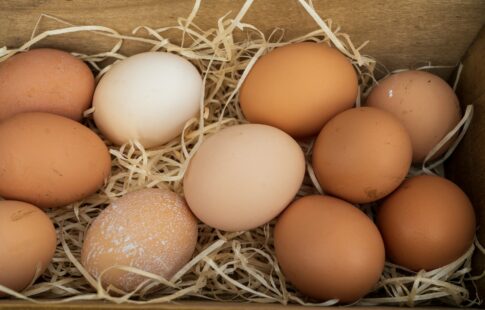
Types of Sustainable Food Packaging
We are reader-supported. When you buy through links on our site, we may earn affiliate commission.
Environmentalists evaluate the size of landfills and the rate we are filling them, assessing the current municipal solid waste (MSW) system’s longevity. They found society has less than two decades before it runs out of landfill space. A significant portion of surface-level waste derives from the un-sustainable food packaging and distribution sector.
Nearly all processed foods come in containers, creating disposal challenges. Glass, aluminum and plastic produce MSW and atmospheric pollution, limiting their sustainability. Environmental scientists developed practical solutions to sustainable food packaging waste using alternative materials and production methods.
The Plastic Problem
Before exploring the sustainable solutions to container waste, we must assess the ecological challenges they respond to. If you open your refrigerator, you may see milk in a plastic jug, berries in plastic holders, eggs in plastic cartons and lettuce in plastic bags. The majority of residential food packaging waste is plastic.
Prior to purchasing food in plastic containers, an unsustainable production process creates atmospheric pollution. Manufacturing a 0.53-quart plastic water bottle releases nearly 82.8 grams of carbon into the environment. The greenhouse gas emissions alter Earth’s composition and its ability to regulate surface temperatures.
The planet uses an effective heat production process to support life on its surface. Naturally, it absorbs sunlight, makes heat, warms its surface, collects unnecessary energy and emits it into space. Carbon dioxide changes the process because it more efficiently produces heat from solar radiation.
It also traps excess energy in the atmosphere, filtering it back through the heat production process. Over time, greenhouse gases raise Earth’s temperature, creating adverse ecological effects. Extended droughts, melting glaciers, food scarcity and forced migration, are some of the impacts of the enhanced greenhouse effect.
Plastics also create surface pollution, directly impacting humanity and various species. When food packaging waste reaches a landfill, it remains there for decades. As the material degrades, it turns into microscopic beads called microplastics.
Stormwater carries the beads to the ocean, where marine life ingests them. Microplastics are endocrine disruptors, causing adverse health effects on aquatic species. The material also impacts humanity when it works its way up the food chain.
When humans consume seafood, they may ingest microplastics, gaining exposure to harmful chemicals. Landfill waste also leaks into the soil, polluting agricultural areas, increasing the chemical content of our food. Other packaging materials also create ecological challenges, decreasing their sustainability.
Other Pollution Challenges
Many shelved items come in aluminum cans. The packaging material uses mined bauxite, processed into alumina. Smelting the substances requires a significant quantity of electricity deriving from fossil fuels.
Over time, the aluminum manufacturing process creates large quantities of greenhouse gas emissions. Glass is another packaging material creating atmospheric pollution. It derives from melted petroleum, oil and natural gas.
During combustion, the fuel sources release greenhouse gases into the atmosphere. Paper and cardboard packages create surface-level degradation from deforestation. Developing enough paper to support container production requires mass vegetation removal.
Clear-cutting causes forced migration, depleting species resources and habitats. Degrading highly populated forests can cause endangerment, leading to biodiversity losses. Food manufacturing and distribution companies can increase their sustainability levels by using eco-friendly packaging materials.
Sustainable Food Packaging Materials
Some eco-conscious companies are creating compostable packages to minimize landfill waste. After consumers use its contents, they can place the container in their composting piles, increasing the health and fertility of their soil. The packages generally derive from organic materials like corn, sugar cane or renewable resources.
Other manufacturers make sustainable containers from recycled materials. When they repurpose waste, they free up landfill space, slowing the rate of expansion. Additionally, recycled packages have smaller carbon footprints, increasing atmospheric conservation.
Bamboo is another eco-friendly packaging material used by food distributors. The plant is sustainable because it grows quickly with little maintenance required. Farmers can produce bamboo without ecologically degrading additives like synthetic fertilizers and pesticides.
When individuals use bamboo for packaging, they reduce deforestation and preserve species’ vital resources. Other companies use rice husks to create eco-conscious containers. The husks are byproducts of rice farming, and they generally make agricultural waste.
Using the husks for packaging reduces surface pollution, giving the material a second life. Companies are using the rice material to create biodegradable bowls, utensils and lunchboxes. Individuals can additionally reduce packaging waste by adopting eco-friendly consumer habits.
Eco-Friendly Consumption Practices
Consumers can shrink their carbon footprints by purchasing food items in sustainable containers. Also, they may avoid plastic packages at grocery stores by bringing their own reusable bags. You can shop at container-less retailers, increasing your access to low-waste products.
Individuals may additionally grow their own food, reducing packaging and transportation waste. You can ensure the minimal impact of your produce when creating it on your property and choosing sustainable food packaging. Over time, small waste-reduction efforts can have a significant effect.
Share on
Like what you read? Join other Environment.co readers!
Get the latest updates on our planet by subscribing to the Environment.co newsletter!
About the author
Jane Marsh
Starting from an early age, Jane Marsh loved all animals and became a budding environmentalist. Now, Jane works as the Editor-in-Chief of Environment.co where she covers topics related to climate policy, renewable energy, the food industry, and more.





